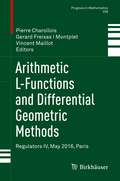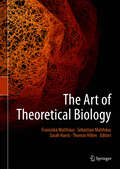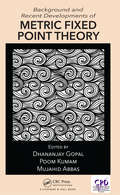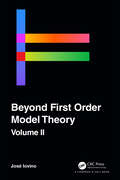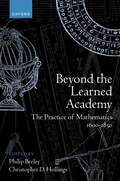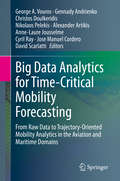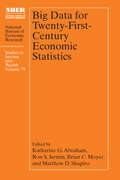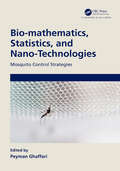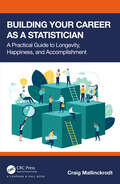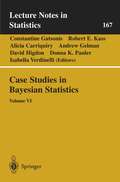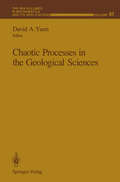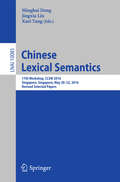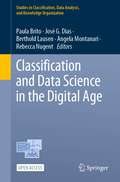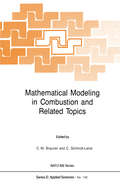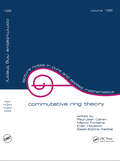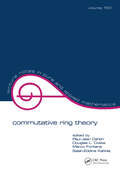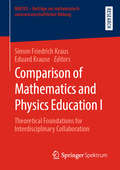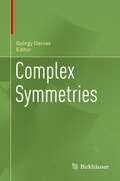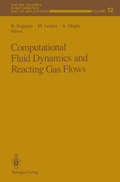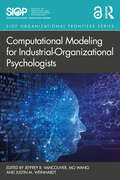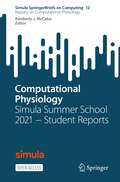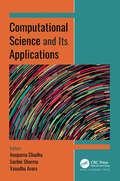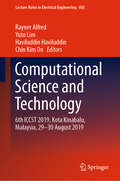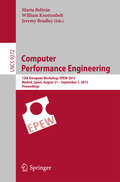- Table View
- List View
Arithmetic L-Functions and Differential Geometric Methods: Regulators IV, May 2016, Paris (Progress in Mathematics #338)
This book is an outgrowth of the conference “Regulators IV: An International Conference on Arithmetic L-functions and Differential Geometric Methods” that was held in Paris in May 2016. Gathering contributions by leading experts in the field ranging from original surveys to pure research articles, this volume provides comprehensive coverage of the front most developments in the field of regulator maps. Key topics covered are:• Additive polylogarithms• Analytic torsions• Chabauty-Kim theory• Local Grothendieck-Riemann-Roch theorems• Periods• Syntomic regulatorThe book contains contributions by M. Asakura, J. Balakrishnan, A. Besser, A. Best, F. Bianchi, O. Gregory, A. Langer, B. Lawrence, X. Ma, S. Müller, N. Otsubo, J. Raimbault, W. Raskin, D. Rössler, S. Shen, N. Triantafi llou, S. Ünver and J. Vonk.
The Art of Theoretical Biology
This beautifully crafted book collects images, which were created during the process of research in all fields of theoretical biology. Data analysis, numerical treatment of a model, or simulation results yield stunning images, which represent pieces of art just by themselves. The approach of the book is to present for each piece of visualization a lucid synopsis of the scientific background as well as an outline of the artistic vision.
Background and Recent Developments of Metric Fixed Point Theory
This book focusing on Metric fixed point theory is designed to provide an extensive understanding of the topic with the latest updates. It provides a good source of references, open questions and new approaches. While the book is principally addressed to graduate students, it is also intended to be useful to mathematicians, both pure and applied.
Beyond First Order Model Theory, Volume II
Model theory is the meta-mathematical study of the concept of mathematical truth. After Afred Tarski coined the term Theory of Models in the early 1950’s, it rapidly became one of the central most active branches of mathematical logic. In the last few decades, ideas that originated within model theory have provided powerful tools to solve problems in a variety of areas of classical mathematics, including algebra, combinatorics, geometry, number theory, and Banach space theory and operator theory. The two volumes of Beyond First Order Model Theory present the reader with a fairly comprehensive vista, rich in width and depth, of some of the most active areas of contemporary research in model theory beyond the realm of the classical first-order viewpoint. Each chapter is intended to serve both as an introduction to a current direction in model theory and as a presentation of results that are not available elsewhere. All the articles are written so that they can be studied independently of one another. This second volume contains introductions to real-valued logic and applications, abstract elementary classes and applications, interconnections between model theory and function spaces, nonstucture theory, and model theory of second-order logic. Features A coherent introduction to current trends in model theory. Contains articles by some of the most influential logicians of the last hundred years. No other publication brings these distinguished authors together. Suitable as a reference for advanced undergraduate, postgraduates, and researchers. Material presented in the book (e.g, abstract elementary classes, first-order logics with dependent sorts, and applications of infinitary logics in set theory) is not easily accessible in the current literature. The various chapters in the book can be studied independently.
Beyond the Learned Academy: The Practice of Mathematics, 1600-1850
The tremendous growth of the mathematical sciences in the early modern world was reflected contemporaneously in an increasingly sophisticated level of practical mathematics in fields such as merchants' accounts, instrument making, teaching, navigation, and gauging. In many ways, mathematics shaped the knowledge culture of the age, infiltrating workshops, dockyards, and warehouses, before extending through the factories of the Industrial Revolution to the trading companies and banks of the nineteenth century. While theoretical developments in the history of mathematics have been made the topic of numerous scholarly investigations, in many cases based around the work of key figures such as Descartes, Huygens, Leibniz, or Newton, practical mathematics, especially from the seventeenth century onwards, has been largely neglected. The present volume, comprising fifteen essays by leading authorities in the history of mathematics, seeks to fill this gap by exemplifying the richness, diversity, and breadth of mathematical practice from the seventeenth century through to the middle of the nineteenth century.
Big Data Analytics for Time-Critical Mobility Forecasting: From Raw Data to Trajectory-Oriented Mobility Analytics in the Aviation and Maritime Domains
This book provides detailed descriptions of big data solutions for activity detection and forecasting of very large numbers of moving entities spread across large geographical areas. It presents state-of-the-art methods for processing, managing, detecting and predicting trajectories and important events related to moving entities, together with advanced visual analytics methods, over multiple heterogeneous, voluminous, fluctuating and noisy data streams from moving entities, correlating them with data from archived data sources expressing e.g. entities’ characteristics, geographical information, mobility patterns, mobility regulations and intentional data. The book is divided into six parts: Part I discusses the motivation and background of mobility forecasting supported by trajectory-oriented analytics, and includes specific problems and challenges in the aviation (air-traffic management) and the maritime domains. Part II focuses on big data quality assessment and processing, and presents novel technologies suitable for mobility analytics components. Next, Part III describes solutions toward processing and managing big spatio-temporal data, particularly enriching data streams and integrating streamed and archival data to provide coherent views of mobility, and storing of integrated mobility data in large distributed knowledge graphs for efficient query-answering. Part IV focuses on mobility analytics methods exploiting (online) processed, synopsized and enriched data streams as well as (offline) integrated, archived mobility data, and highlights future location and trajectory prediction methods, distinguishing between short-term and more challenging long-term predictions. Part V examines how methods addressing data management, data processing and mobility analytics are integrated in big data architectures with distinctive characteristics compared to other known big data paradigmatic architectures. Lastly, Part VI covers important ethical issues that research on mobility analytics should address. Providing novel approaches and methodologies related to mobility detection and forecasting needs based on big data exploration, processing, storage, and analysis, this book will appeal to computer scientists and stakeholders in various application domains.
Big Data for Twenty-First-Century Economic Statistics (National Bureau of Economic Research Studies in Income and Wealth #79)
The papers in this volume analyze the deployment of Big Data to solve both existing and novel challenges in economic measurement. The existing infrastructure for the production of key economic statistics relies heavily on data collected through sample surveys and periodic censuses, together with administrative records generated in connection with tax administration. The increasing difficulty of obtaining survey and census responses threatens the viability of existing data collection approaches. The growing availability of new sources of Big Data—such as scanner data on purchases, credit card transaction records, payroll information, and prices of various goods scraped from the websites of online sellers—has changed the data landscape. These new sources of data hold the promise of allowing the statistical agencies to produce more accurate, more disaggregated, and more timely economic data to meet the needs of policymakers and other data users. This volume documents progress made toward that goal and the challenges to be overcome to realize the full potential of Big Data in the production of economic statistics. It describes the deployment of Big Data to solve both existing and novel challenges in economic measurement, and it will be of interest to statistical agency staff, academic researchers, and serious users of economic statistics.
Bio-mathematics, Statistics, and Nano-Technologies: Mosquito Control Strategies
Finding effective methods for mosquito control remains one of the great global challenges facing this generation. Bio-mathematics, Statistics and Nano-Technologies: Mosquito Control Strategies brings together experts from a large array of disciplines in order to provide a comprehensive overview of cutting-edge techniques to model, analyse and combat mosquito-transmitted vector-borne diseases. Features Includes multiple case studies Suitable for scientists and professionals working on methods for mosquito control and Epidemiology Provide a much-needed focal point for interdisciplinary discussion
Building Your Career as a Statistician: A Practical Guide to Longevity, Happiness, and Accomplishment
This book is intended for anyone who is considering a career in statistics or a related field, or those at any point in their career with sufficient work time remaining such that investing in additional learning could be beneficial. As such, the book would be suitable for anyone pursing an MS or PhD in statistics or those already working in statistics. The book focuses on the non-statistical aspects of being a statistician that are crucial for success. These factors include 1) productivity and prioritization, 2) innovation and creativity, 3) communication, 4) critical thinking and decisions under uncertainty, 5) influence and leadership, 6) working relationships, and 7) career planning and continued learning. Each of these chapters includes sections on foundational principles and a section on putting those principles into practice. Connections between these individual skills are emphasized such that the reader can appreciate how the skills build upon each other leading to a whole that is greater than the sum of its parts. By including the individual perspectives from other experts on the fundamental principles and their application, readers will have a well-rounded view on how to build upon and fully leverage their technical skills in statistics. The primary audience for the book is large and diverse. It will be useful for self-study by virtually any statistician, but could also be used as a text in a graduate program that includes a course on careers and career development.Key Features: Takes principles proven to be useful in other settings and applies them to statisticians and statistical settings. Focused Concise Accessible to all levels, from grad students to mid-later career statisticians.
Case Studies in Bayesian Statistics: Volume VI (Lecture Notes in Statistics #167)
This volume contains invited case studies with the accompanying discussion as well as contributed papers selected by a refereeing process of 6th Workshop on Case Studies in Bayesian Statistics was held at the Carnegie Mellon University in October, 2001.
Chaotic Processes in the Geological Sciences (The IMA Volumes in Mathematics and its Applications #41)
This IMA Volume in Mathematics and its Applications CHAOTIC PROCESSES IN THE GEOLOGICAL SCIENCES is based on the proceedings of a workshop which was an integral part of the 1989- 90 IMA program on "Dynamical Systems and their Applications". The workshop was intended to be an arena for scientific exchanges between earth scientists and mathematical researchers, especially with experts in dynamical systems. We thank Shui-Nee Chow, Martin Golubitsky, Richard McGehee, George R. Sell and David Yuen for organizing the meeting. We especially thank David Yuen for editing the proceedings. We also take this opportunity to thank those agencies whose financial support made the workshop possible: the Army Research Office, the Minnesota Supercomputer Institute, the National Science Foundation, and the Office of Naval Research. A vner Friedman Willard Miller, Jr. PREFACE The problems in geological sciences have many nonlinearities from the nature of the complicated physical laws which give rise to strongly chaotic behavior. Foremost and most visible are earthquakes and volcanic eruptions, more subtle are the time dependent variations of the Earth's magnetic fields and motions of the surface plates.
Chinese Lexical Semantics: 17th Workshop, CLSW 2016, Singapore, Singapore, May 20–22, 2016, Revised Selected Papers (Lecture Notes in Computer Science #10085)
This book constitutes the thoroughly refereed post-workshop proceedings of the 17th Chinese Lexical Semantics Workshop, CLSW 2016, held in Singapore, Singapore, in May 2016. The 70 regular papers included in this volume were carefully reviewed and selected from 182 submissions. They are organized in topical sections named: lexicon and morphology, the syntax-semantics interface, corpus and resource, natural language processing, case study of lexical semantics, extended study and application.
Classification and Data Science in the Digital Age (Studies in Classification, Data Analysis, and Knowledge Organization)
The contributions gathered in this open access book focus on modern methods for data science and classification and present a series of real-world applications. Numerous research topics are covered, ranging from statistical inference and modeling to clustering and dimension reduction, from functional data analysis to time series analysis, and network analysis. The applications reflect new analyses in a variety of fields, including medicine, marketing, genetics, engineering, and education.The book comprises selected and peer-reviewed papers presented at the 17th Conference of the International Federation of Classification Societies (IFCS 2022), held in Porto, Portugal, July 19–23, 2022. The IFCS federates the classification societies and the IFCS biennial conference brings together researchers and stakeholders in the areas of Data Science, Classification, and Machine Learning. It provides a forum for presenting high-quality theoretical and applied works, and promoting and fostering interdisciplinary research and international cooperation. The intended audience is researchers and practitioners who seek the latest developments and applications in the field of data science and classification.
Collected Papers in Honor of Yoshihiro Shibata
Yoshihiro Shibata has made many significant contributions to the area of mathematical fluid mechanics over the course of his illustrious career, including landmark work on the Navier-Stokes equations. The papers collected here — on the occasion of his 70th birthday — are written by world-renowned researchers and celebrate his decades of outstanding achievements.
Commutative Algebra: Proceedings of a Microprogram Held June 15–July 2, 1987 (Mathematical Sciences Research Institute Publications #15)
During late June and early July of 1987 a three week program (dubbed "microprogram") in Commutative Algebra was held at the Mathematical Sciences Research Institute at Berkeley. The intent of the microprogram was to survey recent major results and current trends in the theory of commutative rings, especially commutative Noetherian rings. There was enthusiastic international participation. The papers in this volume, some of which are expository, some strictly research, and some a combination, reflect the intent of the program. They give a cross-section of what is happening now in this area. Nearly all of the manuscripts were solicited from the speakers at the conference, and in most instances the manuscript is based on the conference lecture. The editors hope that they will be of interest and of use both to experts and neophytes in the field. The editors would like to express their appreciation to the director of MSRI, Professor Irving Kaplansky, who first suggested the possibility of such a conference and made the task of organization painless. We would also like to thank the IVISRI staff who were unfailingly efficient, pleasant, and helpful during the meeting, and the manager of MSRI, Arlene Baxter, for her help with this volume. Finally we would like to express our appreciation to David Mostardi who did much of the typing and put the electronic pieces together.
Commutative Ring Theory: Proceedings of the Ii International Conference
Presents the proceedings of the Second International Conference on Commutative Ring Theory in Fes, Morocco. The text details developments in commutative algebra, highlighting the theory of rings and ideals. It explores commutative algebra's connections with and applications to topological algebra and algebraic geometry.
Commutative Ring Theory
" Exploring commutative algebra's connections with and applications to topological algebra and algebraic geometry, Commutative Ring Theory covers the spectra of rings chain conditions, dimension theory, and Jaffard rings fiber products group rings, semigroup rings, and graded rings class groups linear groups integer-valued polynomials rings of finite fractions big Cohen-Macaulay modules and much more!"
Comparison of Mathematics and Physics Education I: Theoretical Foundations for Interdisciplinary Collaboration (MINTUS – Beiträge zur mathematisch-naturwissenschaftlichen Bildung)
This volume, which is the output of a DAAD-funded collaboration between the University of Siegen and the Hanoi National University of Education, discusses and summarizes theoretical foundations of common grounds of mathematics and physics education. This interdisciplinary perspective enables especially teachers who have only been trained in one of these subjects to enrich their pedagogical content knowledge. The starting point is a description of characteristics of the disciplines and their historical genesis, followed by comparative studies. This edited volume brings together thirteen stimulating contributions on educational aspects of both disciplines written jointly by experienced researchers from Germany and Vietnam.
Complex Symmetries
This volume is a collection of essays on complex symmetries. It is curated, emphasizing the analysis of the symmetries, not the various phenomena that display those symmetries themselves. With this, the volume provides insight to nonspecialist readers into how individual simple symmetries constitute complex symmetry. The authors and the topics cover many different disciplines in various sciences and arts. Simple symmetries, such as reflection, rotation, translation, similitude, and a few other simple manifestations of the phenomenon, are all around, and we are aware of them in our everyday lives. However, there are myriads of complex symmetries (composed of a bulk of simple symmetries) as well. For example, the well-known helix represents the combination of translational and rotational symmetry. Nature produces a great variety of such complex symmetries. So do the arts. The contributions in this volume analyse selected examples (not limited to geometric symmetries). These include physical symmetries, functional (meaning not morphological) symmetries, such as symmetries in the construction of the genetic code, symmetries in human perception (e.g., in geometry education as well as in constructing physical theories), symmetries in fractal structures and structural morphology, including quasicrystal and fullerene structures in stable bindings and their applications in crystallography and architectural design, as well as color symmetries in the arts. The volume is rounded of with beautiful illustrations and presents a fascinating panorama of this interdisciplinary topic.
Computational Fluid Dynamics and Reacting Gas Flows (The IMA Volumes in Mathematics and its Applications #12)
This IMA Volume in Mathematics and its Applications COMPUTATIONAL FLUID DYNAMICS AND REACTING GAS FLOWS is in part the proceedings of a workshop which was an integral part of the 1986-87 IMA program on SCIENTIFIC COMPUTATION. We are grateful to the Scientific Committee: Bjorn Engquist (Chairman), Roland Glowinski, Mitchell Luskin and Andrew Majda for planning and implementing an exciting and stimulating year-long program. We especially thank the Workshop Organizers, Bjorn Engquist, Mitchell Luskin and Andrew Majda, for organizing a workshop which brought together many of the leading researchers in the area of computational fluid dynamics. George R. Sell Hans Weinberger PREFACE Computational fluid dynamics has always been of central importance in scientific computing. It is also a field which clearly displays the essential theme of interaction between mathematics, physics, and computer science. Therefore, it was natural for the first workshop of the 1986- 87 program on scientific computing at the Institute for Mathematics and Its Applications to concentrate on computational fluid dynamics. In the workshop, more traditional fields were mixed with fields of emerging importance such as reacting gas flows and non-Newtonian flows. The workshop was marked by a high level of interaction and discussion among researchers representing varied "schools of thought" and countries.
Computational Modeling for Industrial-Organizational Psychologists (SIOP Organizational Frontiers Series)
This collection provides a primer to the process and promise of computational modeling for industrial-organizational psychologists. With contributions by global experts in the field, the book is designed to expand readers’ appreciation for computational modeling via chapters focused on key modeling achievements in domains relevant to industrial-organizational psychology, including decision making in organizations, diversity and inclusion, learning and training, leadership, and teams.To move the use of computational modeling forward, the book includes specific how-to-chapters on two of the most commonly used modeling approaches: agent-based modeling and system dynamics modeling. It also gives guidance on how to evaluate these models qualitatively and quantitatively, and offers advice on how to read, review, and publish papers with computational models. The authors provide an extensive description of the myriad of values computational modeling can bring to the field, highlighting how they offer a more transparent, precise way to represent theories and can be simulated to offer a test of the internal consistency of a theory and allow for predictions. This is accompanied by an overview of the history of computational modeling as it relates to I-O psychology. Throughout, the authors reflect on computational modeling’s journey, looking back to its history as they imagine its future in I-O psychology.Each contribution demonstrates the value and opportunities computational modeling can provide the individual researcher, research teams, and fields of I-O psychology and management. This volume is an ideal resource for anyone interested in computational modeling, from scholarly consumers to computational model creators.Chapter 1 of this book is freely available as a downloadable Open Access PDF at http://www.taylorfrancis.com under a Creative Commons Attribution-Non Commercial-No Derivatives (CC-BY-NC-ND) 4.0 license.
Computational Physiology: Simula Summer School 2021 − Student Reports (Simula SpringerBriefs on Computing #12)
This open access volume compiles student reports from the 2021 Simula Summer School in Computational Physiology. Interested readers will find herein a number of modern approaches to modeling excitable tissue. This should provide a framework for tools available to model subcellular and tissue-level physiology across scales and scientific questions. In June through August of 2021, Simula held the seventh annual Summer School in Computational Physiology in collaboration with the University of Oslo (UiO) and the University of California, San Diego (UCSD). The course focuses on modeling excitable tissues, with a special interest in cardiac physiology and neuroscience. The majority of the school consists of group research projects conducted by Masters and PhD students from around the world, and advised by scientists at Simula, UiO and UCSD. Each group then produced a report that addreses a specific problem of importance in physiology and presents a succinct summary of the findings. Reports may not necessarily represent new scientific results; rather, they can reproduce or supplement earlier computational studies or experimental findings. Reports from eight of the summer projects are included as separate chapters. The fields represented include cardiac geometry definition (Chapter 1), electrophysiology and pharmacology (Chapters 2–5), fluid mechanics in blood vessels (Chapter 6), cardiac calcium handling and mechanics (Chapter 7), and machine learning in cardiac electrophysiology (Chapter 8).
Computational Science and Its Applications
This new volume explores the overlapping behavior of some aspects of computational science, focusing on the intersection of computing hardware, algorithms, mathematics, and data management components. The chapters discuss the various application areas of the computational science techniques such as artificial intelligence, machine learning, data science, quantum computing, image processing, evolutionary algorithms, process simulation, deep learning, big data analysis, etc.
Computational Science and Technology: 6th ICCST 2019, Kota Kinabalu, Malaysia, 29-30 August 2019 (Lecture Notes in Electrical Engineering #603)
This book gathers the proceedings of the Sixth International Conference on Computational Science and Technology 2019 (ICCST2019), held in Kota Kinabalu, Malaysia, on 29–30 August 2019. The respective contributions offer practitioners and researchers a range of new computational techniques and solutions, identify emerging issues, and outline future research directions, while also showing them how to apply the latest large-scale, high-performance computational methods.
Computer Performance Engineering: 12th European Workshop, EPEW 2015, Madrid, Spain, August 31 - September 1, 2015, Proceedings (Lecture Notes in Computer Science #9272)
This book constitutes the refereed proceedings of the 12th European Workshop on Computer Performance Engineering, EPEW 2015, held in Madrid, Spain, in August/September 2015. The 19 papers presented in this volume were carefully reviewed and selected from 39 submissions. They were organized in topical sections named: applications; modelling techniques, software performance, and simulation techniques.
